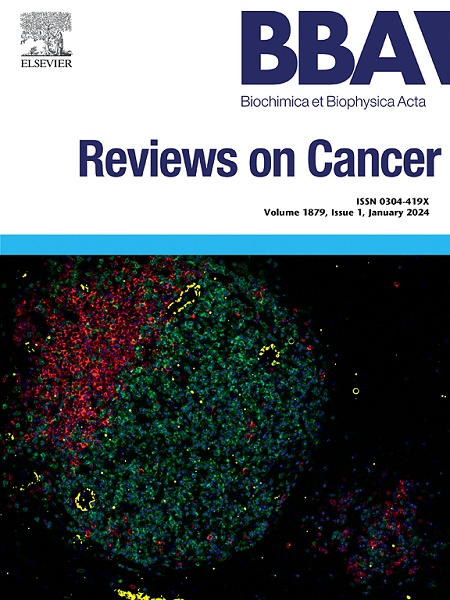缺氧在细胞外囊泡介导的肿瘤细胞与周围微环境之间的细胞间通讯中起关键作用。
IF 9.7
1区 医学
Q1 BIOCHEMISTRY & MOLECULAR BIOLOGY
Biochimica et biophysica acta. Reviews on cancer
Pub Date : 2025-02-01
DOI:10.1016/j.bbcan.2024.189244
引用次数: 0
摘要
过去几年中,人们越来越关注细胞外囊泡(EVs)作为细胞间通信介质在癌症中的作用。这些小颗粒介导细胞间重要生物活性分子的转移,参与恶性肿瘤的发生和发展。缺氧或低氧分压被认为是实体瘤的一个显著特征,并已被证明对肿瘤预后和疗效产生深远影响。事实上,实体瘤的高生长率和混乱的新生血管结构导致肿瘤微环境(TME)中的氧压大大降低。为了应对缺氧条件,肿瘤细胞及其周围环境会形成同态适应机制,从而有助于建立一种有利于肿瘤的表型。最新证据表明,肿瘤周围的缺氧微环境可能是导致癌症患者体内循环 EVs 水平升高的关键因素。因此,有人提出,EVs 可能在缺氧条件下起到介导细胞间通讯的作用。本综述将重点讨论在缺氧的肿瘤组织间质(TME)中,肿瘤细胞与其周围的免疫细胞、内皮细胞和基质细胞群之间由 EVs 介导的串联。本文章由计算机程序翻译,如有差异,请以英文原文为准。
Hypoxia as a critical player in extracellular vesicles-mediated intercellular communication between tumor cells and their surrounding microenvironment
In the past years, increasing attention has been paid to the role of extracellular vesicles (EVs) as mediators of intercellular communication in cancer. These small size particles mediate the intercellular transfer of important bioactive molecules involved in malignant initiation and progression. Hypoxia, or low partial pressure of oxygen, is recognized as a remarkable feature of solid tumors and has been demonstrated to exert a profound impact on tumor prognosis and therapeutic efficacy. Indeed, the high-pitched growth rate and chaotic neovascular architecture that embodies solid tumors results in a profound reduction in oxygen pressure within the tumor microenvironment (TME). In response to oxygen-deprived conditions, tumor cells and their surrounding milieu develop homeostatic adaptation mechanisms that contribute to the establishment of a pro-tumoral phenotype. Latest evidence suggests that the hypoxic microenvironment that surrounds the tumor bulk may be a clincher for the observed elevated levels of circulating EVs in cancer patients. Thus, it is proposed that EVs may play a role in mediating intercellular communication in response to hypoxic conditions. This review focuses on the EVs-mediated crosstalk that is established between tumor cells and their surrounding immune, endothelial, and stromal cell populations, within the hypoxic TME.
求助全文
通过发布文献求助,成功后即可免费获取论文全文。
去求助
来源期刊

Biochimica et biophysica acta. Reviews on cancer
医学-生化与分子生物学
CiteScore
17.20
自引率
0.00%
发文量
138
审稿时长
33 days
期刊介绍:
Biochimica et Biophysica Acta (BBA) - Reviews on Cancer encompasses the entirety of cancer biology and biochemistry, emphasizing oncogenes and tumor suppressor genes, growth-related cell cycle control signaling, carcinogenesis mechanisms, cell transformation, immunologic control mechanisms, genetics of human (mammalian) cancer, control of cell proliferation, genetic and molecular control of organismic development, rational anti-tumor drug design. It publishes mini-reviews and full reviews.
 求助内容:
求助内容: 应助结果提醒方式:
应助结果提醒方式:


